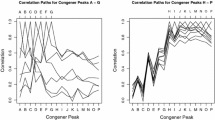Abstract
Most studies on the half-lives of environmental contaminants have been based on small sample sizes and a limited number of repeated measurements. In this paper, we address issues of study design and sample size for half-life studies. Useful guidelines are provided for choosing the number of repeats and the optimal time interval between repeats for estimating an individual's half-life with a given level of precision, while minimizing the cost of the study. In addition, sample size and power considerations for studies comparing two population half-lives are investigated. An example is presented using data from a study on polychlorinated biphenyls and breast cancer.
Similar content being viewed by others
References
Chen PH, Luo ML, Wong CK, Chen CJ (1982) Comparative rates of elimination of some individual polychlorinated biphenyls from the blood of PCB-poisoned patients in Taiwan. Fd Chem Toxicol 20:417–425
Cox DR, Hinkley DV (1974) Theoretical statistics. Chapman and Hall, New York
Elo O, Vuojolahti P, Janhunen H, Rantanen J (1985) Recent PCB accidents in Finland. Environ Health Persp 60:315–319
Lawton RW, Brown JF Jr, Ross MR, Feingold J (1985) Comparability and precision of serum PCB measurements. Arch Environ Health 40:29–37
Phillips DL, Smith AB, Burse VW, Steele GK, Needham LL, Hannon WH (1989) Half-life of polychlorinated biphenyls in occupationally exposed workers. Arch Environ Health 44:351–354
Phillips DL (1989) Propagation of error and bias in half-life estimates based on two measurements. Arch Environ Contam Toxicol 18:508–514
Press WH, Flannery BP, Teukolsky SA, Vetterling WT (1986) Numerical recipes. Cambridge University Press, Cambridge, MA
Schlesselman JJ (1973) Planning a longitudinal study: Frequency of measurement and study duration. J Chron Dis 26:561–570
Steele G, Stehr-Green P, Welty E (1986) Estimates of the biologic half-life of polychlorinated biphenyls in human serum. New Engl J Med 314:926–927
Toniolo P, Pasternack B, Shore R, Sonnenschein E, Koenig K, Rosenberg C, Strax P, Strax S (1991) Endogenous hormones and breast cancer: A prospective cohort study. Breast Cancer Res Treat 18:S23-S26
Wolff MS, Rivera M, Baker DB (1991) Detection limits of organochlorine pesticides and related compounds in blood serum. Bull Environ Contam Toxicol 47:499–503
Wolff MS, Toniolo PG, Lee EW, Dubin N (1993) Blood levels of organochlorine residues and risk of breast cancer. J Natl Cancer Inst 85:648–652
Yakushiji T, Watanabe I, Kuwabara K, Tanaka R, Kashimoto T, Kunita N, Hara I (1984) Rate of decrease and half-life of polychlorinated biphenyls in the blood of mothers and their children occupationally exposed to PCBs. Arch Environ Contam Toxicol 13:341–345
Author information
Authors and Affiliations
Rights and permissions
About this article
Cite this article
Kim, M.Y., Dubin, N. Study design and sample size considerations for half-life studies. Arch. Environ. Contam. Toxicol. 30, 423–429 (1996). https://doi.org/10.1007/BF00212304
Received:
Revised:
Issue Date:
DOI: https://doi.org/10.1007/BF00212304




